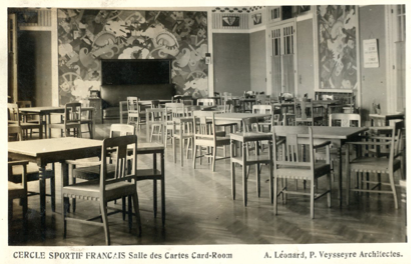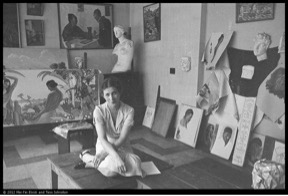Archive
Victor Podgoursky
- Victor
- Podgoursky
Victor Podgursky; Виктор Степанович Подгурский
- 01-09-1893
- Tomsk (RU)
- 1969
- Tashkent (UZ)
- ArtistDesignerTeacher
Victor Podgoursky spent more than twenty-five years in Shanghai, working as an artist, teacher and designer. As a long-standing member of the Shanghai Art Club, he acted as the resident art critic and an instructor in life drawing and painting for the members.
Word Count: 43
Victor Podgoursky, photography (© Nikolay Kradin). 
Street plan of the corner of Avenue Dubail and Avenue Joffre, where Podgoursky’s studio was located (© Institut d’Asie Orientale). 
Interior showing the card room of the French Club, postcard, collection of the author. The murals were made by Victor Podgoursky. 
Victor Podgoursky, Peking Street Scene, oil painting, 1938 (© Podgourski Family Club). 
Musicians, oil painting, photographed in Podgoursky’s studio, Shanghai, 1940 (© 2012 Mei-Fang Elrick and Tess Johnston, Historical Photographs of China, www.hpcbristol.net). 
Victor Podgoursky's studio at 6 Avenue Dubail, 1940, Shanghai (© 2012 Mei-Fang Elrick and Tess Johnston, Historical Photographs of China, www.hpcbristol.net). Kerchelaeva, Nina. “Vernut is zabvenia (To return from oblivion).” Klub Directorov. 12 March 1999.
Artchive.ru. "Victor Stepanovich Podgoursky." https://artchive.ru/artists/69943~Viktor_Stepanovich_Podgurskij. Accessed 1 January 2020.
Lebedeva, Tatiana, “Na perekrestke kultur: Victor Podgoursky, hudozhnik I pedagog (At the crossroads of cultures: Victor Podgoursky, artist and educator)”. Art of East Europe, vol. 2, 2014.
Knyazeva, Katya. "Victor Podgoursky. Building Russian Shanghai." https://sites.google.com/view/russianshanghai/architects/l-z/v-s-podgoursky. Accessed 11 January 2020.Word Count: 69
Shanghai, China (1920–1947)
Joffre Terrace, 927 Avenue Joffre, French Concession (now Huaihai Lu, Xuhui) (residence in the 1920s); 79 Rue Pere Robert (residence); 6 Avenue Dubail (now 447–479 Huaihai Zhong Lu, Xuhui Qu) Shanghai
- Shanghai
- Katya Knyazeva. "Victor Podgoursky." METROMOD Archive, 2021, https://archive.metromod.net/viewer.p/69/2952/object/5138-11320445, last modified: 08-05-2021.
-
Friedrich Hermann SchiffArtistCartoonistDesignerShanghai
Friedrich Schiff was an Austrian-born artist who went to Shanghai in 1930. He became known for his humorous cartoons, which were enjoyed by the colonial bourgeoisie.
Due to his Jewish origins, he was unable to return to Austria after Hitler’s annexation of Austria in 1938. He left Shanghai for Buenos Aires in 1947.Word Count: 51
Ivan KouninJournalistPublisherShanghaiA self-driven journalist and a self-funded publisher, Ivan Kounin created several illustrated albums focused on the life of Shanghai’s international community, which highlighted the work of Russian artists.
Word Count: 29
Alexander A. YaronDesignerJournalistArtistPhotographerShanghaiAn autodidact and a versatile commercial artist, Alexander Yaron applied his talent in portraiture, photography, interior design, advertising, layout and illustration. His best known projects were illustrated art magazines and books produced as part of Adcraft Studios, in tandem with Ivan Kounin.
Word Count: 42
Emmanuel GranArchitectTeacherShanghaiA stateless Russian Jew exiled in Shanghai, Emmanuel Gran rose to become the most accomplished and the most prolific of the diaspora architects. His projects included dozens of public and commercial buildings, apartments and villas in Shanghai and elsewhere in China; close to twenty of them still stand in downtown Shanghai.
Word Count: 51
Mikhail KichiginArtistDesignerTeacherShanghaiMikhail Kichigin was Shanghai’s preeminent émigré artist in the 1930s and 1940s. He travelled extensively around China and Eastern Asia, exhibiting his work and conducting visual studies. A versatile professional and a respected art instructor, he influenced a number of young artists from the Russian diaspora.
Word Count: 47
Thais JasparArtistShanghaiCombining the vocation of philanthropist with that of an artist, Thais Jaspar was equally at ease among the foreign elites and Soviet diplomats in Shanghai. Her pleasing portraiture was much in demand by her friends and clients.
Word Count: 37
Vera KuznetzovaArtistDesignerIllustratorShanghaiA native of Harbin and a resident of Shanghai in the 1930s and 1940s, Vera Kuznetzova was among the most accomplished female artists of the Russian diaspora. Together with Mikhail Kichigin, she travelled extensively around China and Eastern Asia, exhibiting her work and conducting visual studies.
Word Count: 46
Vasily ZasipkinArtistDesignerShanghaiVasily Zasipkin was a prolific artist and and influential teacher, much loved in the diaspora. Having lost his studio and all his work in wartime Shanghai, he started over in Singapore.
Word Count: 31
Emma BormannArtistShanghaiEmma Bormann was a pioneering artist and printmaker. Her oeuvre gives witness to her extensive travels around the globe and to the agility and versatility of her artistic rendering of the urban sites she encountered.
Word Count: 35
PonedelnikAssociationShanghaiPonedelink was the most influential and the longest-running art society in Shanghai. Committed to promoting awareness of Russian culture and to developing its members' taste and erudition, it published the finest art magazine of the diaspora.
Word Count: 36
Victor SassoonEntrepreneurShanghaiVictor Sassoon was a descendant of the Baghdadi Jewish Sassoon merchant family. He contributed significantly to a real estate boom in Shanghai in the 1920s and 1930s and helped European Jews in the Shanghai Ghetto. An ambitious amateur photographer, he produced many images of people and events of the time.
Word Count: 50